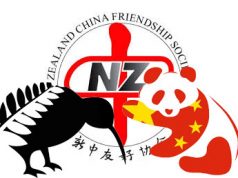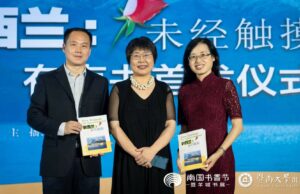NEXT BRANCH MEETING
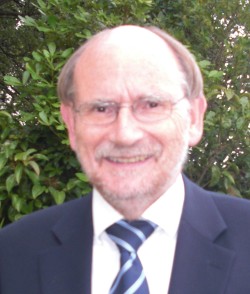 Mr. Chris Elder will speak on “With the Benefit of Foresight: China’s World in 2031”
Mr. Chris Elder will speak on “With the Benefit of Foresight: China’s World in 2031”
Chris Elder first travelled to China in 1973, as a member of the Walding Ministerial Mission to mark the establishment of relations. From 1974 to 1976 he was on the staff of the New Zealand Embassy in Beijing. He returned to Beijing as Ambassador from 1993 to 1997. Chris has researched and written a range of books and articles on China and China/New Zealand relations. He currently holds the position of Special Adviser – China, in the Ministry of Foreign Affairs and Trade.
Wednesday, 19 October 2011, at 5:45 pm, Connolly Hall, Guildford Terrace, off Hill Street, Thorndon, Wellington.
(Car park up Guildford Tce beside Hall)
An optional Chinese buffet meal, supplied by the Fujiyama Café, will follow the meeting at 7 pm. Orders for the $11.00 meal (please pay at the door) will be taken up till 6 pm. If you think you may be arriving late, please let the Secretary know in advance.
ALSO COMING UP THIS MONTH
1, 8, 29 October 3:15pm Mandarin Corner, 20 Kelburn Parade
26 October 7:00pm Film Evening, 101 Wakefield St
See below for further details.
NEW MEMBERS – A warm welcome to Tony Burge, David Burt and Yu Zhangbao.
IDIOM OF THE MONTH (from George Mills)
欲速则不达 (yù sù zé bù dá) More haste, less speed
REPORT ON LAST MEETING – HARMONY IS MOST PRECIOUS(from Joy Bickley-Asher)
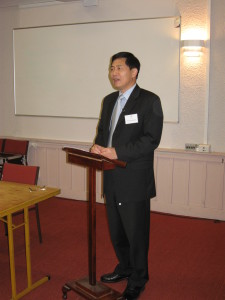
China is in good shape and will continue to rely on its own strengths and independence in order to make progress. The top priority of the Chinese government is China’s own development. These were the main messages I took from His Excellency Mr Xu Jianguo’s illuminating address to the Wellington branch of the NZ China Friendship Society on 21 September 2011.
The focus on internal development does not signal a new adherence to an isolationist foreign policy. Rather, the tone of the Ambassador’s remarks led me to believe that China wants to engage with other countries on a friendly and peaceful basis. It was significant that Mr Xu began his presentation with a warm acknowledgement of the outstanding contribution the New Zealand-China Friendship Society has made to China, particularly through the promotion of friendly relations between our two countries. He made favourable comments about New Zealand’s social security system, our efforts at environmental protection and the efficiency of our management systems.
Regarding the priorities for the Chinese government, His Excellency Mr Xu focused on the economic outlook and China’s foreign policy. China responded to the 2008 global recession by such measures as injecting 4000 billion RMB into the internal Chinese economy. The main purpose of this was to maintain confidence through rapid and stable internal development. It also helped to shield the Chinese economy from external shocks. Economic and social challenges facing the Chinese government include the effects of earlier, less balanced and sustainable economic models and the growing gap between rich and poor people.
China’s foreign policy will continue to be based on peaceful independence because it has worked in the past. Having friendly relations with other countries not only fits with China’s interests but also harmonises with an international trend towards peace.
At the conclusion of his presentation, the large audience showed their appreciation of Mr Xu’s readiness to speak so openly and engagingly with them.
MEETING DATES FOR THE REST OF 2011
November 16, Wednesday 5.45pm: Mr David Feickert, “Mine Safety in China: Lessons for New Zealand”
BATIK PRINTING (from George Mills)
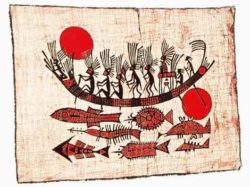 Batik printing is a age-old traditional folk handicraft for fabric printing and dyeing in China. It was named together with tie dyeing and stencil printing as “Three Major Printing Crafts in Ancient China”. Stripes on wax printed cloth result from natural chapping of wax, which contributes to the uniqueness of every wax printed work. Batik printing is thus known as a sort of cloth painting with “Fingerprints”. Featuring rich patterns, elegant colours and peculiar styles, wax printed cloth is used to make costumes, trappings and various living utensils with primitive, novel, eye-catching and ethnic characteristics. Known as “laxie” in ancient times, batik printing is a time-honoured dye-proof craft in China. The traditional craft for batik printing has been spreading in some minority regions in Southwest China and has been inherited and carried forward in minority regions in Guizhou Province. Presently, it has served as an indispensable art in the life of women in these regions. Trappings worn by them such as handkerchiefs, belly bands, clothes, skirts and leg wrappings are without exception made by batik printing. Batik printing features prevalent in the art of different ethnic minorities in Guizhou Province are diversified. For example, wax printed patterns prevailing in the Miao ethnic group are of bronze drum patterns passed down from ancient times. Such patterns also take folk tales or commonly seen flowers, birds, insects and fish as the subject matter. In contrast, geometrical patterns are popular with the Buyi ethnic group. Having been handed down from generation to generation in minority regions in Southwest China, the art of batik printing has been endowed with a peculiar artistic style and enjoys the fame of “ethnic artistic flower of distinctive Chinese features”. Wax printed products made by handicraftsmen and women from this region of China are marketed globally and represent a unique aspect of Chinese art. (cultural-china.com; edited)
Batik printing is a age-old traditional folk handicraft for fabric printing and dyeing in China. It was named together with tie dyeing and stencil printing as “Three Major Printing Crafts in Ancient China”. Stripes on wax printed cloth result from natural chapping of wax, which contributes to the uniqueness of every wax printed work. Batik printing is thus known as a sort of cloth painting with “Fingerprints”. Featuring rich patterns, elegant colours and peculiar styles, wax printed cloth is used to make costumes, trappings and various living utensils with primitive, novel, eye-catching and ethnic characteristics. Known as “laxie” in ancient times, batik printing is a time-honoured dye-proof craft in China. The traditional craft for batik printing has been spreading in some minority regions in Southwest China and has been inherited and carried forward in minority regions in Guizhou Province. Presently, it has served as an indispensable art in the life of women in these regions. Trappings worn by them such as handkerchiefs, belly bands, clothes, skirts and leg wrappings are without exception made by batik printing. Batik printing features prevalent in the art of different ethnic minorities in Guizhou Province are diversified. For example, wax printed patterns prevailing in the Miao ethnic group are of bronze drum patterns passed down from ancient times. Such patterns also take folk tales or commonly seen flowers, birds, insects and fish as the subject matter. In contrast, geometrical patterns are popular with the Buyi ethnic group. Having been handed down from generation to generation in minority regions in Southwest China, the art of batik printing has been endowed with a peculiar artistic style and enjoys the fame of “ethnic artistic flower of distinctive Chinese features”. Wax printed products made by handicraftsmen and women from this region of China are marketed globally and represent a unique aspect of Chinese art. (cultural-china.com; edited)
NATIONAL DAY DINNER CELEBRATING THE 62nd ANNIVERSARY OF THE FOUNDING OF THE PRC (from Luke Qin 秦瞳)
On 19 September, Wellington Chinese Association, Poon Fah Association, Seyip Association, Tung Jung Association and NZ China Friendship Society Wellington Branch together hosted a National Day Dinner at the Grand Century Restaurant to celebrate the 62nd Anniversary of the founding of the People’s Republic of China.
The gongs and drums worked the atmosphere to fever pitch as passers-by were wowed by the introduction of the fabled Lion Dance. The near 200 strong guests consisting of Chinese embassy representatives, established & new settlers and kiwi friends were treated to a Chinese cultural feast that raised a proverbial tempest in Windy Wellington.
A rousing rendition of the Chinese and New Zealand national anthems in Chinese, Maori and English was a fitting reflection of the outpouring attachment to the homeland and the longing for a brighter future in NZ.
Wellington Chinese Association President Steven Young welcomed the guests on behalf of the organizers and expressed his great wishes to the Wellington Chinese community and the motherland. NZ China Friendship Society Wellington Branch President Bernie Richmond briefed guests on the exchange programmes and initiatives currently underway and the progress made by the NZCFS towards forging a mutually beneficial relationship between the two great nations. Wellington Deputy Mayor Ian McKinnon put his Mandarin and Cantonese skills to the test, acknowledging the huge contribution made by the Chinese community to the city of Wellington. Counselor Mr. CHENG Lei of the Chinese Embassy spoke in English of the monumental results China has achieved under scientific development and brought from home the best wishes to the overseas Chinese.
Regardless of when we first arrived in NZ; whether or not we were born here; what we do for a living; whether we speak Cantonese, Mandarin or English, the Middle Kingdom has left an indelible imprint on us from the very first day we were born and our destiny will always be inalienably linked with the fortunes of our homeland. Although as we say in Chinese “the burden is heavy and the road is long”, a confident and prosperous China is in the dream of every overseas Chinese.
MANDARIN CORNER 汉语角 3.15pm – 4.30pm Saturdays during school terms
Mandarin Corner currently meets Saturdays (excluding school holidays), 3.15-4.30 pm at the Seminar Room, 20 Kelburn Parade, Victoria University of Wellington. There is a topic for each session to stimulate interest.
All welcome. Gold coin donation.
Three sessions in October: 1 October – Shanghai Expo Follow-up (上海世博会后续), 8 October – Tea Appreciation 茶艺), 29 October – Er Hu 二胡 (Chinese violin)
Contact: Ellen Yang, 473-7558, 027-4756888, [email protected].
CHINESE FILM 中国电影 Date: Wednesday 26 October Time: 7.00pm – 9:30pm
Venue: Committee Room One, Wellington City Council, 101 Wakefield Street. Gold coin donation.
A Review of the Centennial Development of China’s Film Industry (百年光影)
China’s first movie was made in 1905 when great changes were taking place in Chinese society. Films, as vivid records of the times, have since then recorded all the happenings of China in the century. Films enrich people’s lives and inspire their spirit. To mark the 100th anniversary of the Chinese film industry, this documentary has chosen and highlighted the events and figures of milestone significance in “Chinese films and films of China” to probe how Chinese films have developed from entertainment to enlightenment, and to show a centennial splendour and glory of the Chinese film industry. Preceded by a short documentary 7:00 – 7:30pm.
CONFUCIUS INSTITUTE NEWS (from Director LUO Hui)
On 20 September 2011, the Confucius Institute at VUW, in association with Volunteer Wellington, presented its first Discover China! Day at St. John’s on Willis Street. The 4-hour event comprised of informal cultural classes on language, calligraphy, martial arts and tea appreciation. Twenty-two people, including staff from the IAG and Eftpos, participated in the free event. With the success of this pilot run, the CI plans to bring Discover China! Day to more schools and community centres in Wellington.
Music continues to thrive at the CI. On 28 October, the CI will present a Chinese piano concert – 12+1: Childhood Memories. The concert features performances by NZSM piano lecturer and Yale School of Music graduate Jian Liu and twelve NZSM students. Venue: Hunter Council Chamber. Time: 6:00-7:30pm, 28 October. Free Entry.
At the invitation of the CI, two distinguished scholars from China will give two public lectures on 2 November. Prof. Wang Xu from Xiamen University will speak on ‘China’s Urbanization at a New Stage’; Prof. Tao Wenzhao from the Chinese Academy of Social Sciences will give a talk on ‘China-US Relations under the Obama Administration’. Venue: Chancellor 4 Room, James Cook Hotel. Time: 1:30-5:00pm, with coffee break between the two talks. All Welcome.
A gentle reminder for those interested in taking the upcoming Chinese Proficiency Tests at the CI: Registration deadline for HSK (adults) is 7 November; deadline for YCT (intermediate and secondary students) is 16 October; deadline for BCT (Business Chinese) is 10 October. To register, please contact [email protected]. For updates on CI news and events, please visit http://www.victoria.ac.nz/ci.
ISSUES AFFECTING THE AUTO MARKET IN CHINA, AND PLANNED SOLUTIONS (from George Mills)

The China auto industry produced 18 million vehicles in 2010—the highest annual volume in any country in history. For comparison, auto manufacturers in the US produced 17 million units a year in the early 2000s. With this volume, China is facing challenges in four main areas: energy, environment, safety, and congestion. Energy: more than 50 percent of China’s oil is imported, and in the last five years the country’s greatest increase in oil use was from transportation. The concern is how China will sustain an auto industry when roughly 96 percent of its cars may run on gasoline. Environment: although China has made major accomplishments reducing auto emissions in the past 10-20 years, it still has many buses and trucks with old technologies. In many major cities, one-third of air pollutants are auto related. Safety: while China has far fewer cars on the street—probably 1/6th in the US—and far fewer auto-related accidents than in the US, China has 10 or 12 times more auto-related fatalities than in America. This is because most people that are hurt in car accidents in China are pedestrians. Finally, congestion: many cities are suffering from congestion. In January 2011, Beijing issued a new policy to limit issuance of new car license plates to 240,000 plates a year. In 2010, 700,000 new cars were sold in Beijing. To address these issues, in 2010 GM China developed a blue paper that outlines its vision for the future of sustainable mobility. The blue paper discusses technical solutions to reach sustainable urban mobility through vehicles that are increasingly powered by electricity, connected continuously to communications infrastructure, electrically controlled through power equipment when desired, and flexibly designed to meet specific usage requirements. When most people think of the challenges of sustainable mobility they think of energy, fuel economy, and emissions—but they may not realize congestion and safety are equal challenges. The connectivity concept introduces cars that emit signals and thus can “talk” to each other and detect their surroundings, including other vehicles and pedestrians on the street. This will reduce the possibility of auto accidents and improve electric battery efficiency. GM is also working on improving the fuel efficiency of the internal combustion engine. (Comments made by David S. Chen, VP of GM China Group to the China Business Review; edited) (Note: An article in the International Herald Tribune from 4 September 2011, titled “China Aims to Rein In Car Sales”, details the Chinese government’s plans to reverse the growth in car sales in China.)
CHINESE NURSES LEARN A LOT FROM WENCHUAN EARTHQUAKE (from Joy Bickley-Asher)
Collaborative research by academics in Adelaide, Australia and Chongqing, China has shown that Chinese nurses had both good and bad experiences while helping after the Wenchuan earthquake. Ten nurses aged between 30 and 43 reported being afraid of dying, and feeling overwhelmed by the enormity of their task ‘We had to make a great effort to maintain order’, ‘I watched a girl die half-way through digging her out’, ‘We had to work as housekeepers and search for food, cook and arrange accommodation for the entire rescue team’. They found themselves adapting such things as IV lines to make catheters and providing health advice to their co-rescuers. Because of their isolation they learned to rely totally on one another for support. The experience helped them to rediscover the caring aspect of nursing and made them feel stronger and more compassionate. ‘At night, looking after patients in the field using torches and kneeling on the wet ground I felt I was the Lantern Goddess guarding the wounded’. Assessment skills and clinical judgement helped the rescue nurses to win time to save people’s lives. Their lack of education in disaster preparedness was a barrier to their effectiveness and made things harder for them. More comprehensive research on other disasters in e.g., Iran, Taiwan and Indonesia has found similar results. The main conclusion is that health professionals likely to help in disaster relief need advanced education and skills well in advance of any disaster.
Yang, Y-N., Xiao, L.D., Cheng, Y-H., Zhu, J-C., & Abon, P. (2010). International Nursing Review, 57, 217-223.


